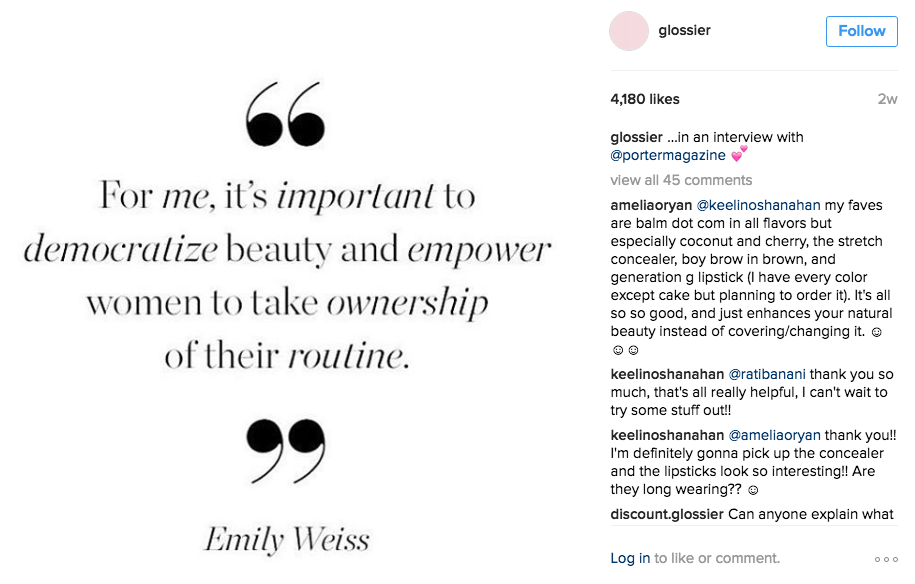Beauty in Real Life: Glossier's Post-Feminist Beauty Agenda
I won persistent acne in the genetic lottery, and was applying a full face of makeup from the time I entered middle school. While most of my classmates slept until the last possible minute, I was awake at 6am performing a tedious procedure: wash, tone, don’t pick, medicate, moisturize. After makeup, concealing was the last and most crucial step. At summer camps and sleepovers, I spent a lot of time justifying my lengthy routine to my baby–faced friends. For them, the equation was simple: wash your face, no spots. I didn’t have the luxury of blasé.
It’s therefore not surprising that over the years, I developed an obsessive tendency to research skincare products in my spare time. In between countless dermatologist visits and treatments, I cultivated an indexical knowledge of beauty brands. I knew which foundations wore best in what climate, the top serums for scarring, and where on the Internet to get prescription–grade acid peels.
In college, my acne lessened in severity. I began a total phase-out of acne products for sexier treatments: serums, masks, lotions, and peels with sleek packaging superseded tubes of zit cream. At the same time, my obsession with skincare was further fueled when I discovered Into the Gloss, a blog founded by former Vogue staffer Emily Weiss as a virtual salon for successful, attractive women – from actors and models to editorial directors and writers – to unapologetically divulge their beauty routines, health practices, and other topics that have historically been considered “fluff.” Written in the first person, reading a “Top Shelf” post is intimate; it feels like Jenna Lyons or Karlie Kloss is speaking directly to you about their favorite lipstick or body lotion.
Naturally, Into the Gloss became the first site that I’d check in the morning, eager to read the latest “Top Shelf” interview about a fashion editor who keeps $500 moisturizer next to drugstore shampoo, or about a stylist’s two-week cleanse in Tuscany after too many $1 pizza slices in NYC.
I, along with thousands of English-reading beauty enthusiasts, was sucked in (to the gloss). With each new feature, the site’s editorial candor framed the aspirational as quotidian – it normalized the idea of luxury for a mass audience. During the height of beauty blogging, Into the Gloss helped legitimize beauty as a collective cultural practice.
When the retail offspring of Into the Gloss launched in 2014, it immediately generated a legion of followers. Glossier was to be “a beauty company inspired by what real girls need in real life.” Two years later, Glossier is an omnipresent force in millennial beauty, proselytizing a “skincare first” philosophy for “cool girls,” selling a range of barebones products the website says will “live with you, not on you.”
Glossier is the spirit of Into the Gloss in bottled form. It’s the culmination of “Top Shelf” interviews combined with careful planning and marketing expertise. Together, Into the Gloss and Glossier create one self-reflexive system with a following of “cool girls,” a “girl gang” (phrases Glossier and its consumers often use) whose favorite color is often tagged as #glossierpink. As a “digitally-native,” social media-created and -operated brand, Glossier is succeeding without appearing to try too hard. This is why Glossier is often heralded as revolutionary, because it literally gets inside the mind of the Glossier girl, or as writer Nitasha Tiku recently put it, “Glossier wants to be your BFF.” [1]
I bought into it. I ordered Glossier’s “Perfecting Skin Tint,” “Stretch Concealer,” and “Boy Brow,” three popular items “designed to work together to perfect (not conceal!) skin,” ostensibly requiring minimal effort to achieve ideal results. When my #glossierpink box arrived, it came with stickers and a giant poster of a close-up of one of their model’s faces, “no filter, just Glossier.” The first thing I noticed was the extreme fluid consistency of my new non-makeup. After I finished applying, the end result didn’t evoke Glossier’s troop of “real girl” models (many of whom actually work at Glossier’s headquarters). I was simply moisturized, with acne scarring and some breakouts: a real girl, indeed. There was clearly a disconnect between the “real girls in real life” mantra and Glossier’s extremely high resolution, well lit, and color corrected images of their products on models.
Glossier never suggests that being high maintenance is counter to their mission, just that skin should come first; and the skin I see on Glossier’s site is impeccably dewy. “Skin is in,” says Glossier. “We’re not here to cover you up.”
This covering up and skin being “in” conversation is actually ancient. A Platonic archetype is at the core of any beauty endeavor positioning skin and makeup as binary. Glossier’s “new essentials” (face wash, tinted moisturizer, concealer) are perhaps entirely based on notions of real and fake, of authentic and inauthentic. We are in a moment when “real” has become paramount in beauty advertising. Dove’s “Real Beauty” campaigns from a few years ago seemed to open the floodgates to well-intentioned but misguided theses on authenticity and truth, using “un-photoshopping” as a marketing tactic. Because it works. And Glossier gets that.
I’m glad Glossier exists, not least because I enjoy rose–scented face wash at a good price point. Glossier perfectly exemplifies our ambiguous cultural moment; one that seamlessly integrates finely tuned feminist rhetoric with consumerism. But when most of what society thinks about women is based on appearance, Glossier’s crowd-sourced vernacular of “imperfection” might just be another standard to meet, a Françoise Hardy or Kate Moss 2.0. A woman’s cultural capital is contingent to how well she performs consumerism at any given moment, whether the popular fashion is to relish goods or reject them for a “moral” cause. Historically, femininity has been determined on this principle. Glossier is just one current manifestation of this history, your beauty “BFF” for this exact moment.
Notes
[1]Nitasha Tiku. “Inside Glossier: The Beauty Brand That Just Happens to Sell Makeup.” Buzzfeed, 25 August 2016. https://www.buzzfeed.com/nitashatiku/inside-glossier-the-beauty-startup-that-just-happens-to-sell?utm_term=.ih6aOA1Ra#.fkAQ816rQ
(Thumbnail Image by Lauren Downing Peters)



